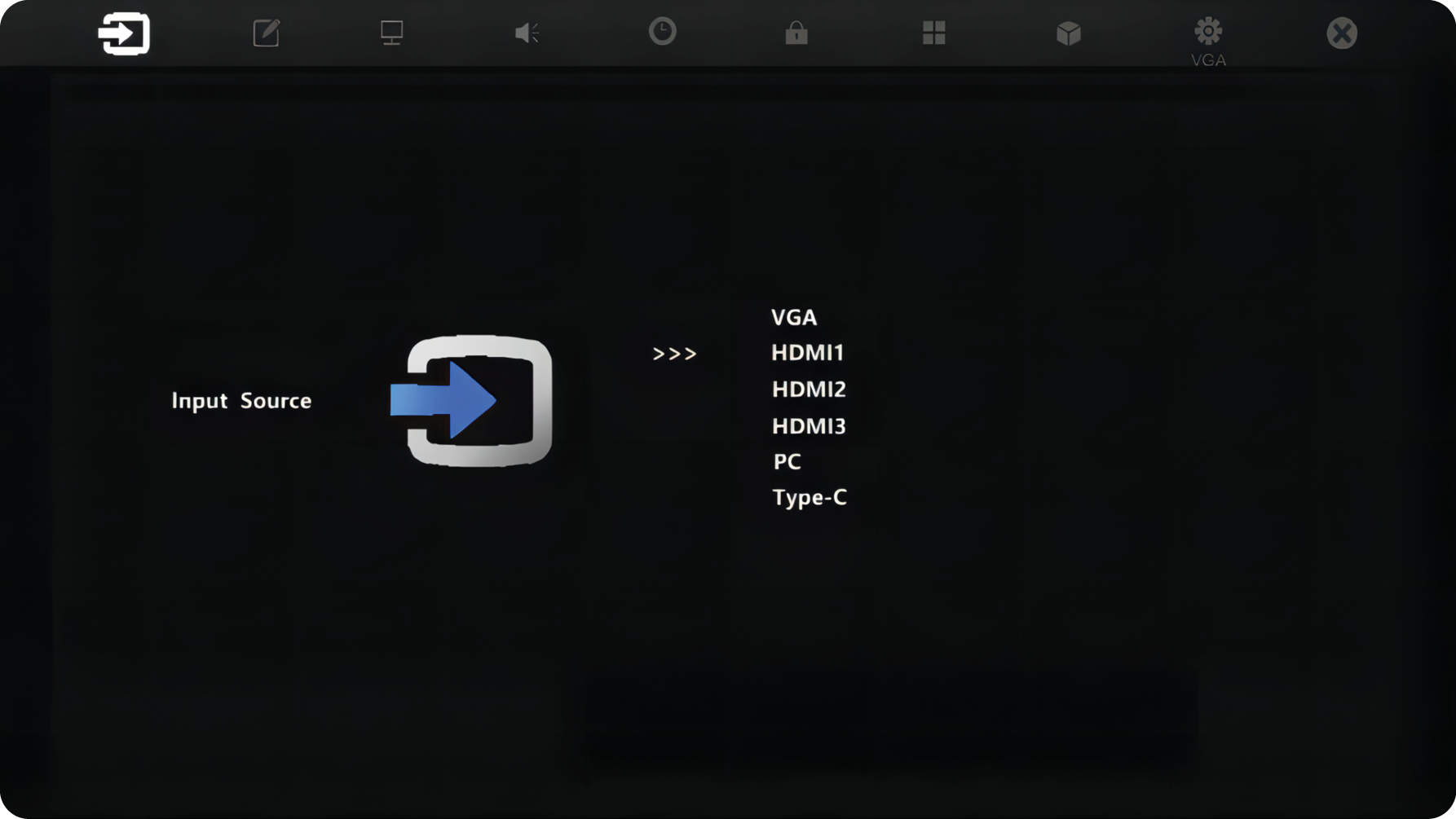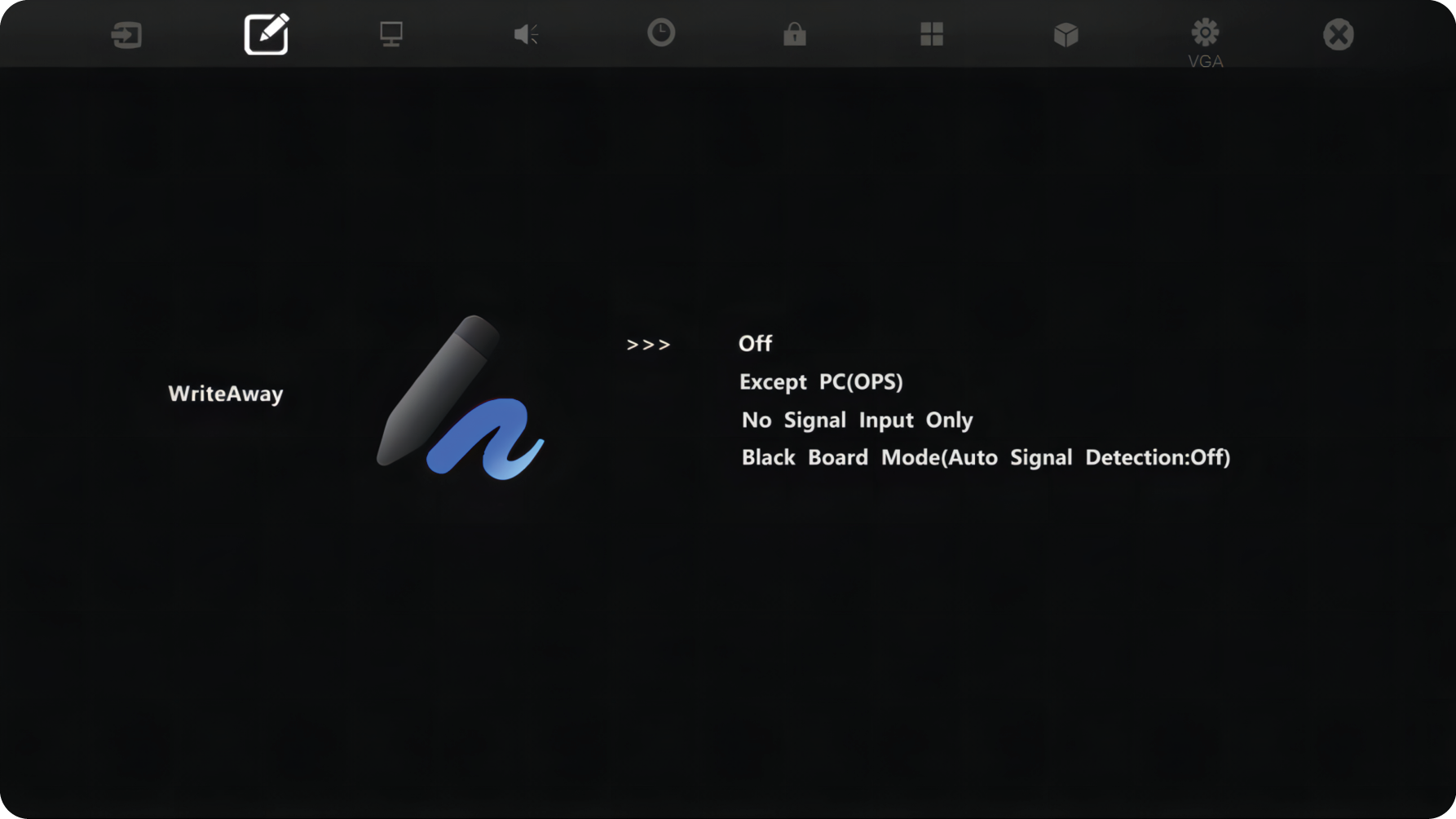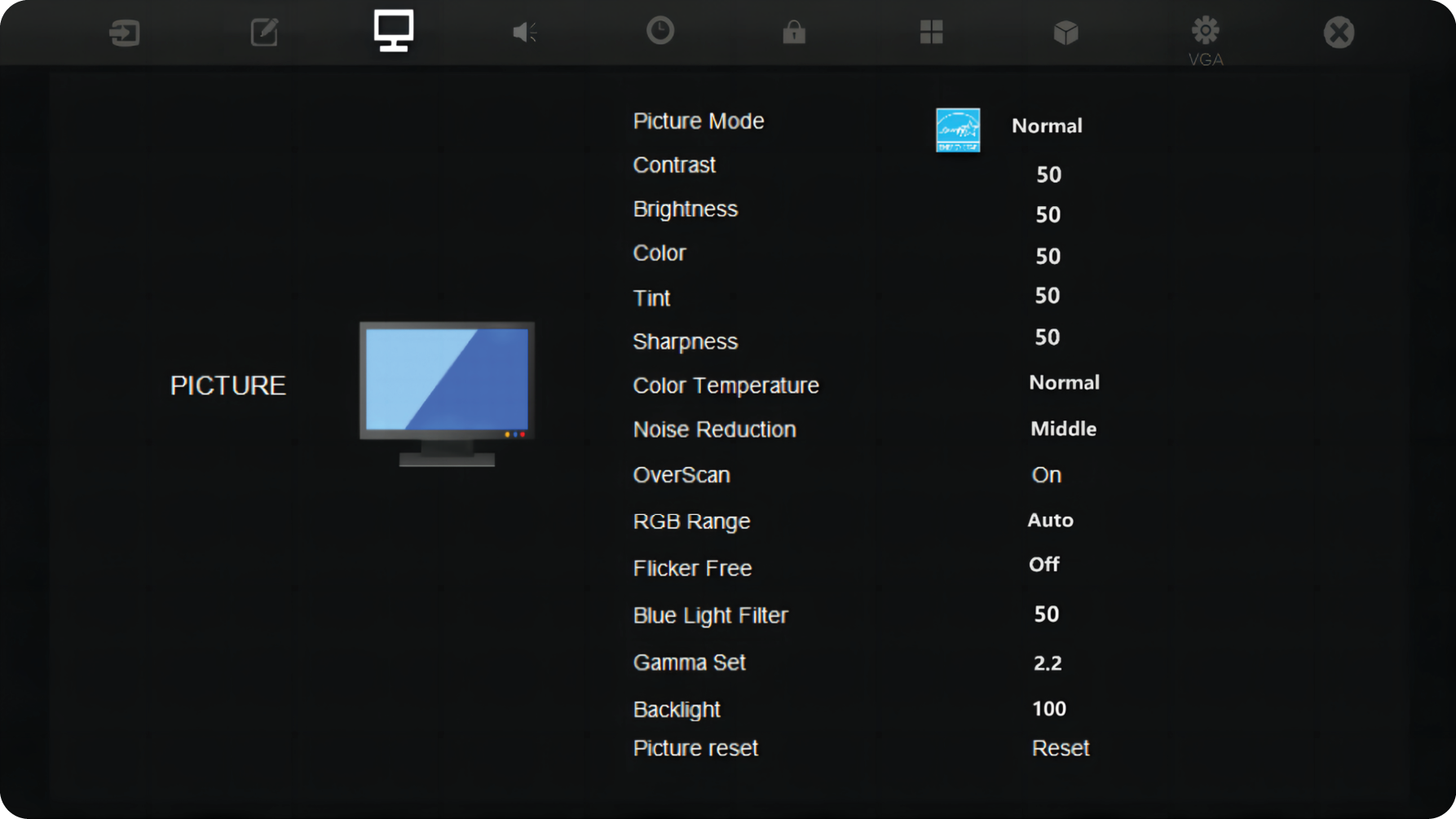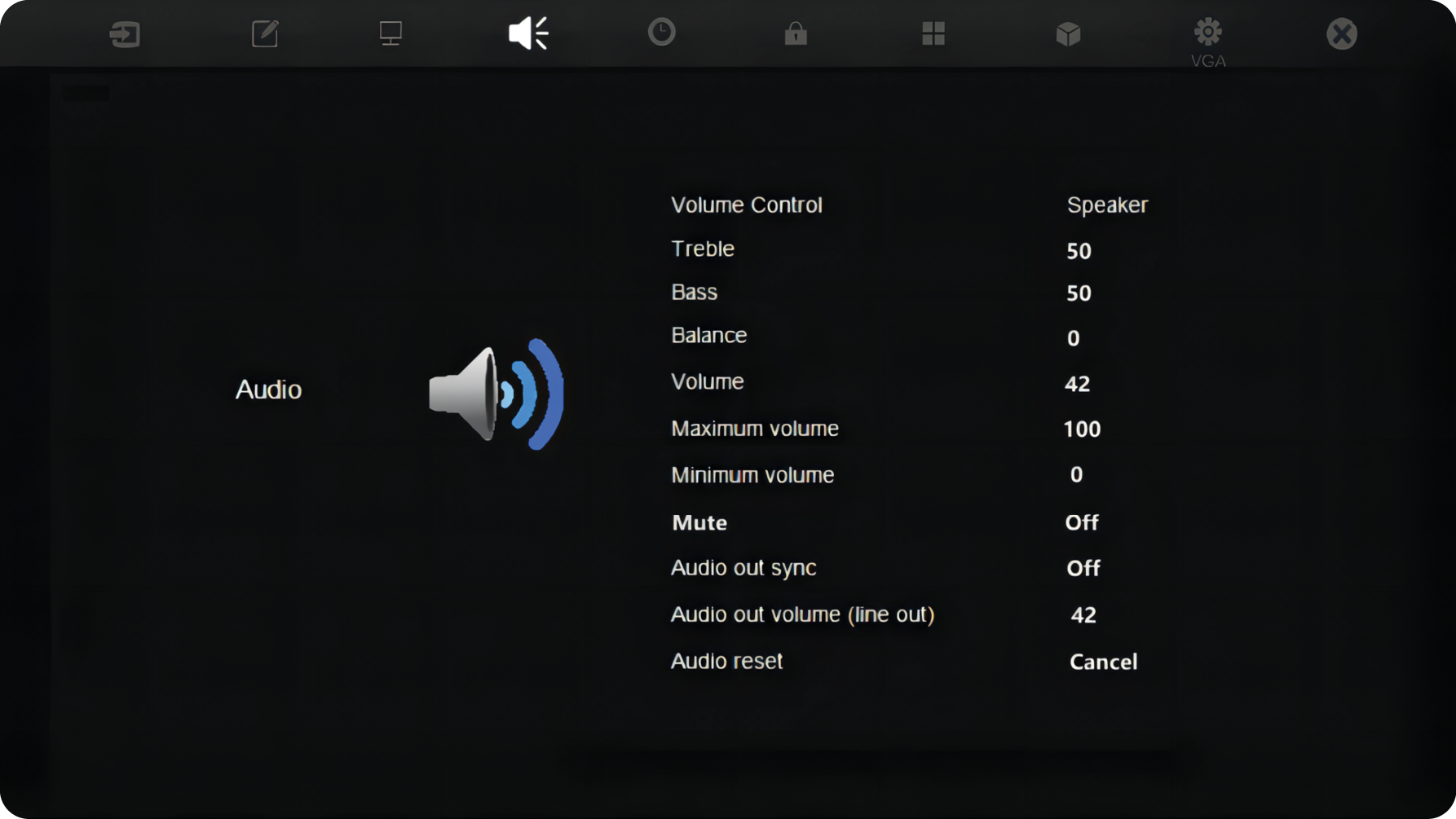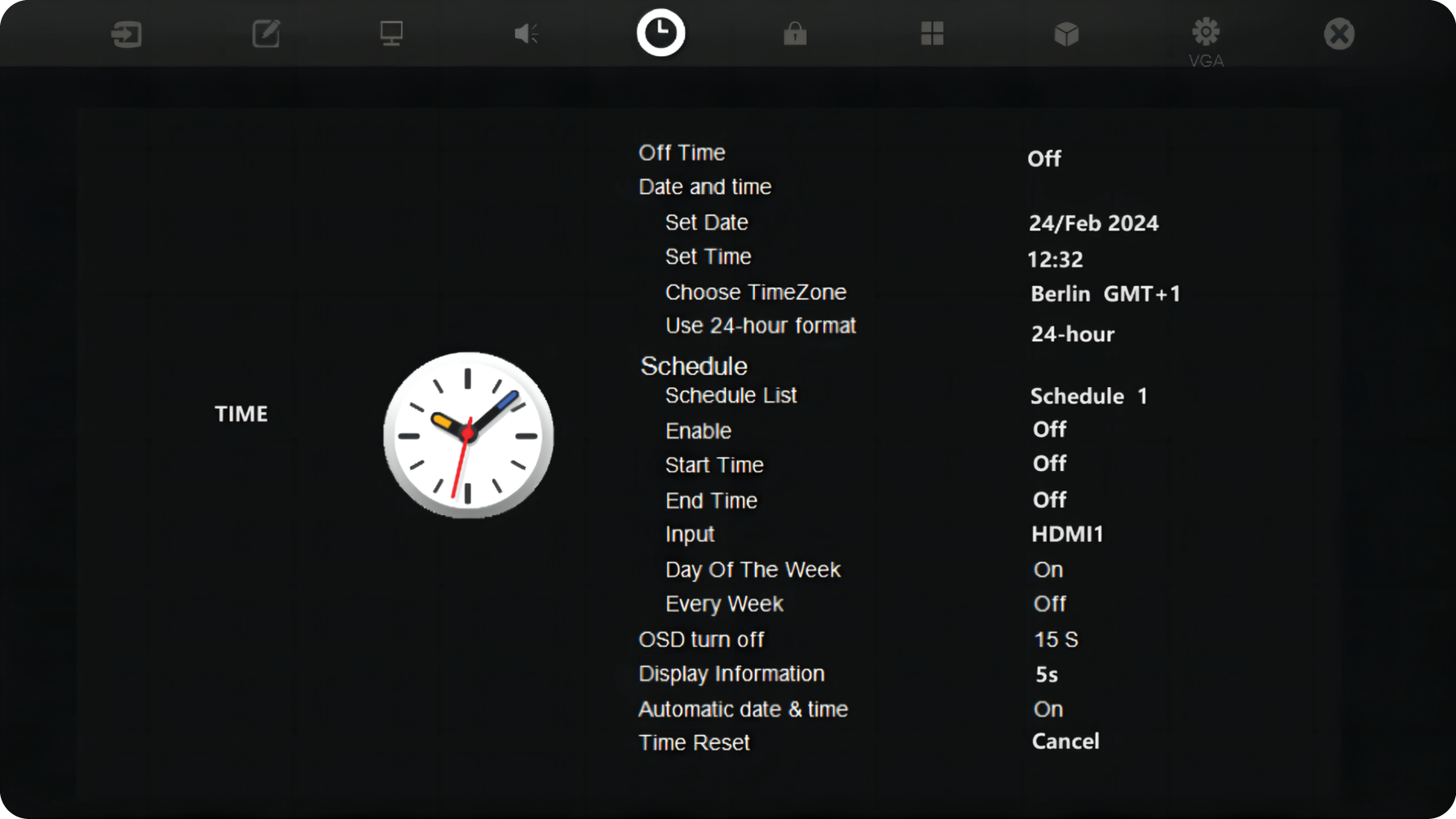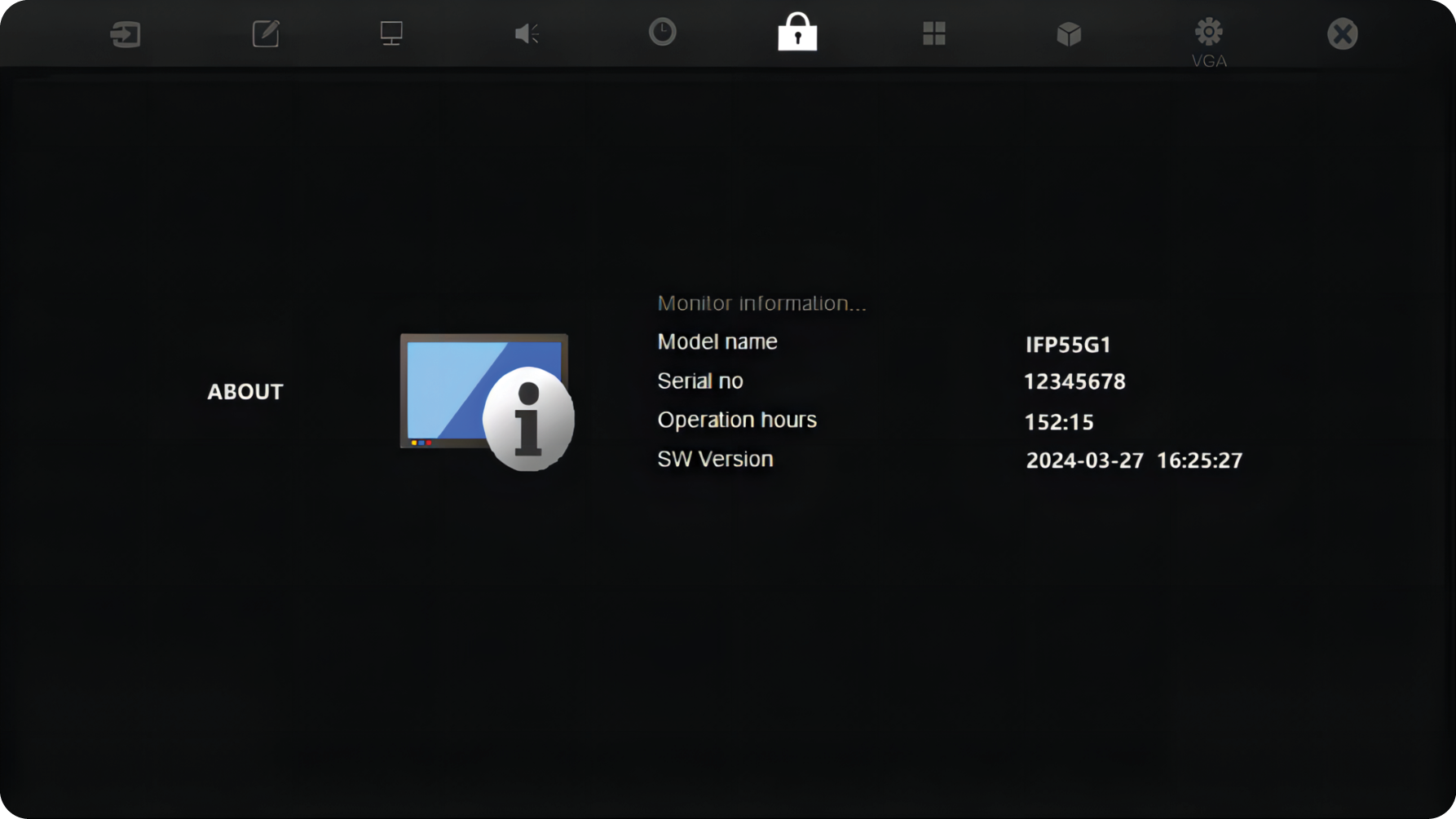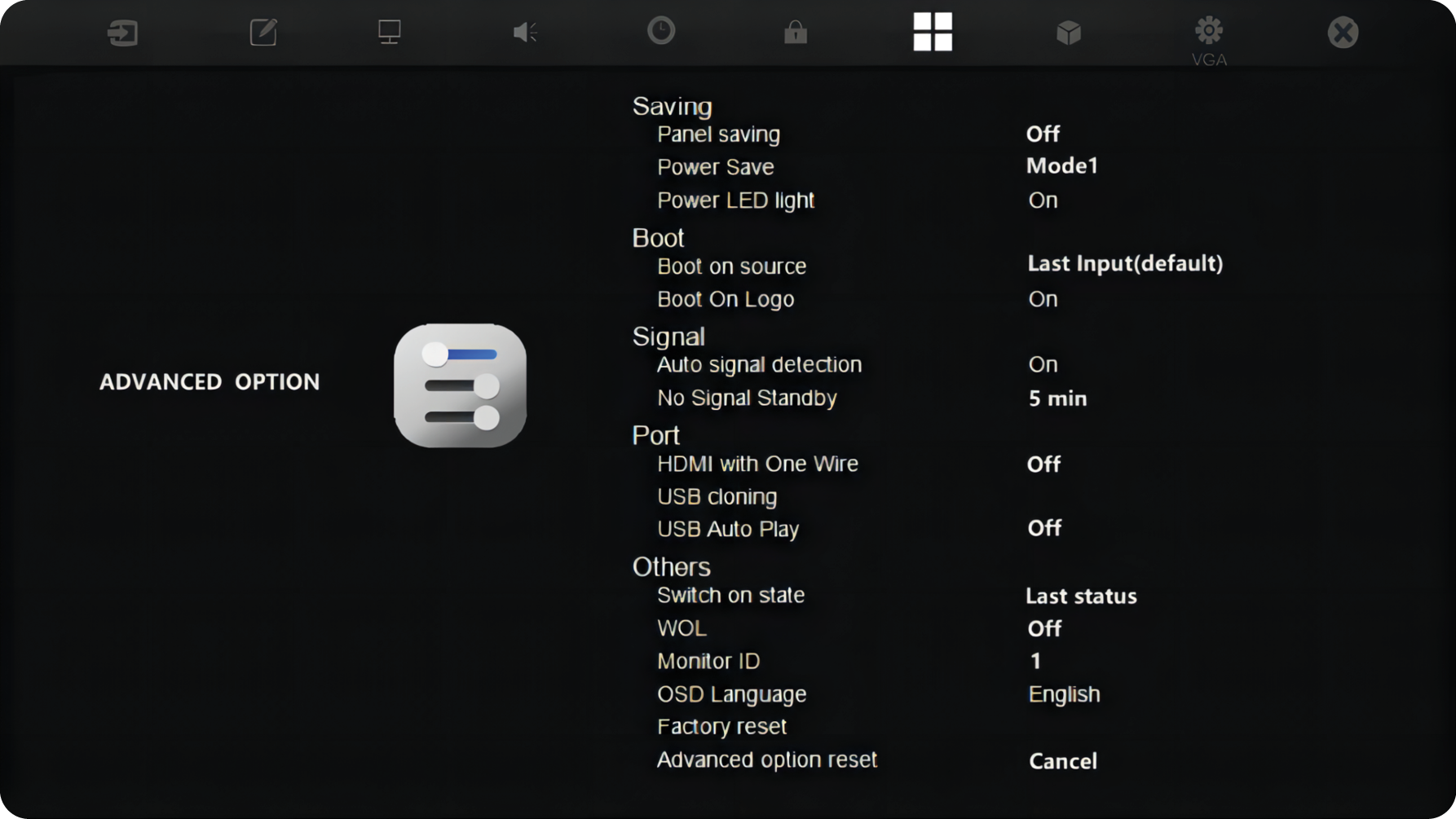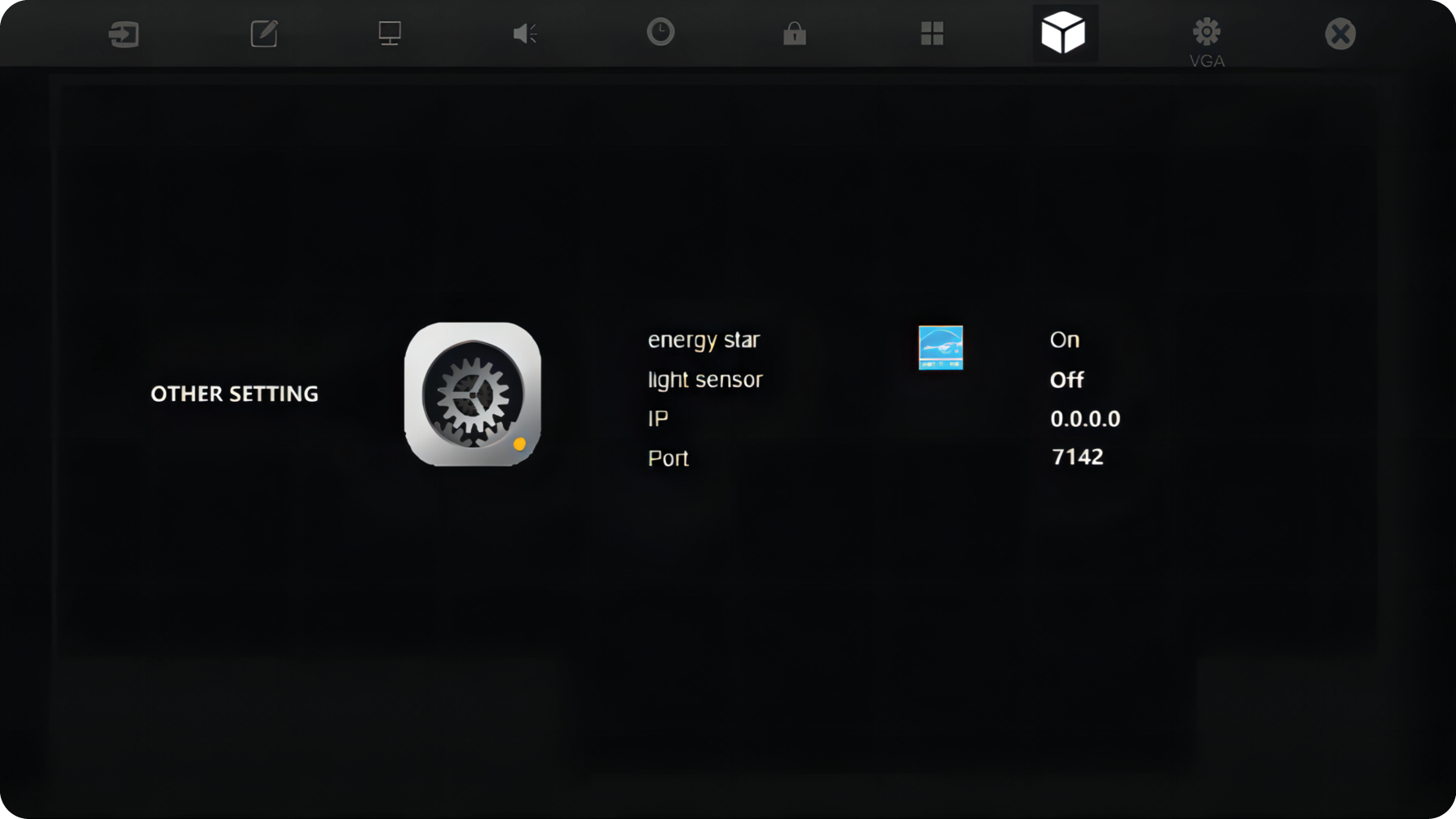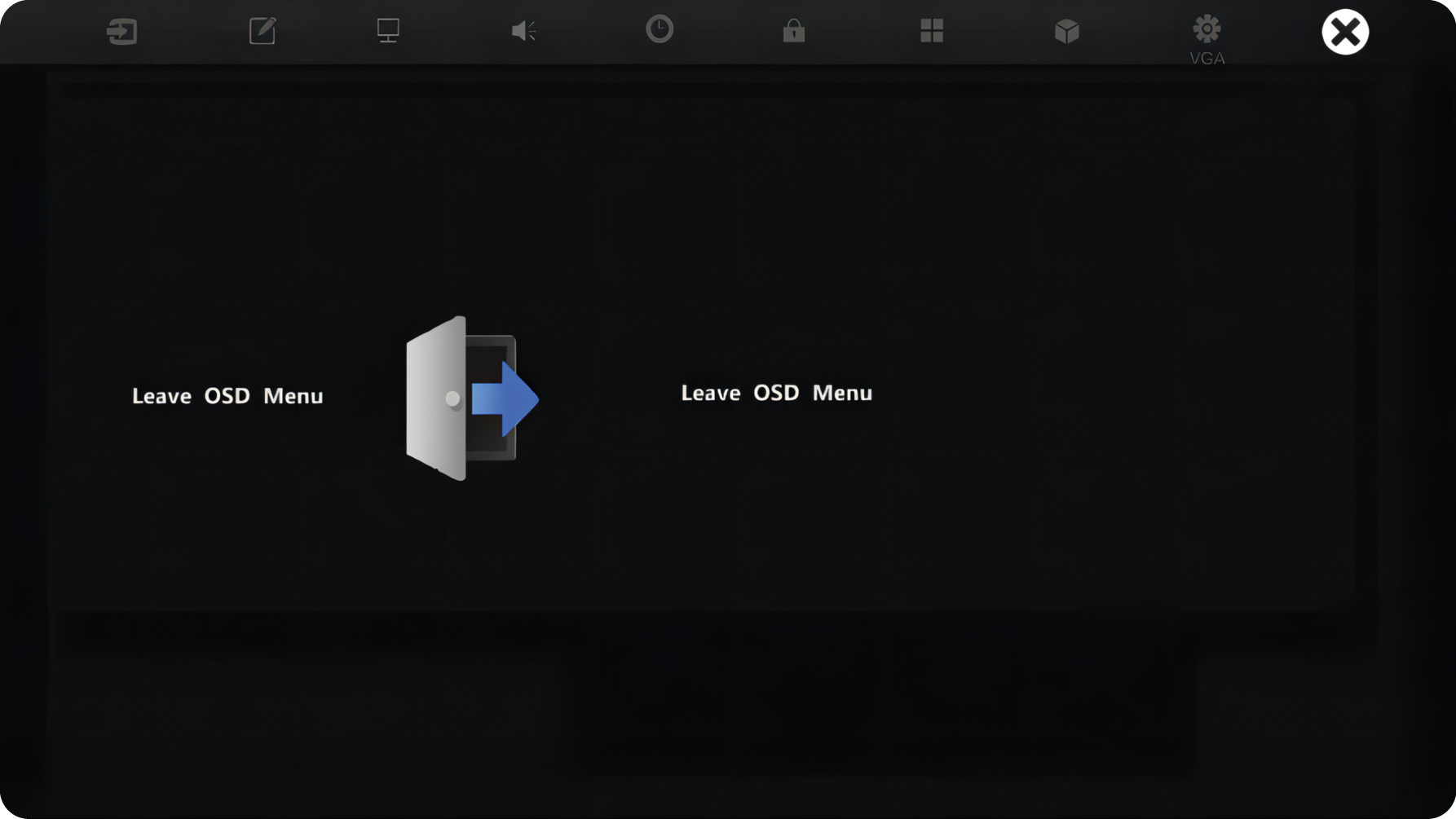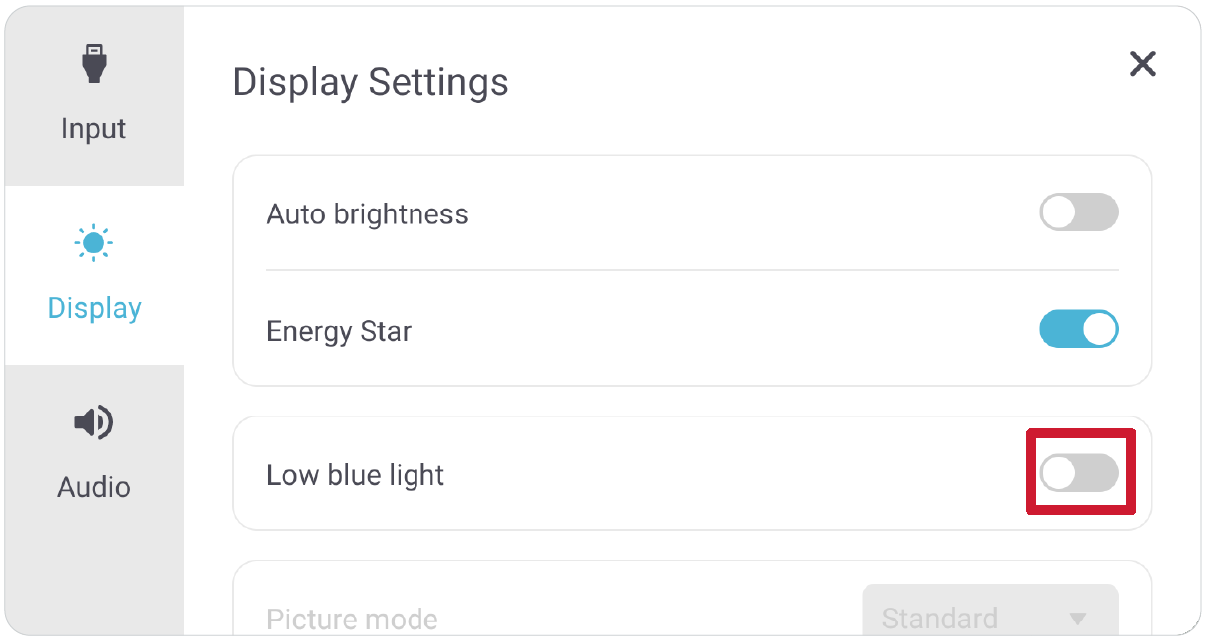IFP65G1 On-Screen Display Operation
On-Screen Display (OSD) Menu Operation
Access VGA, Input Source, WriteAway, Picture, Audio, Time, About, Advanced Options, and Other Settings settings through the OSD Menu.
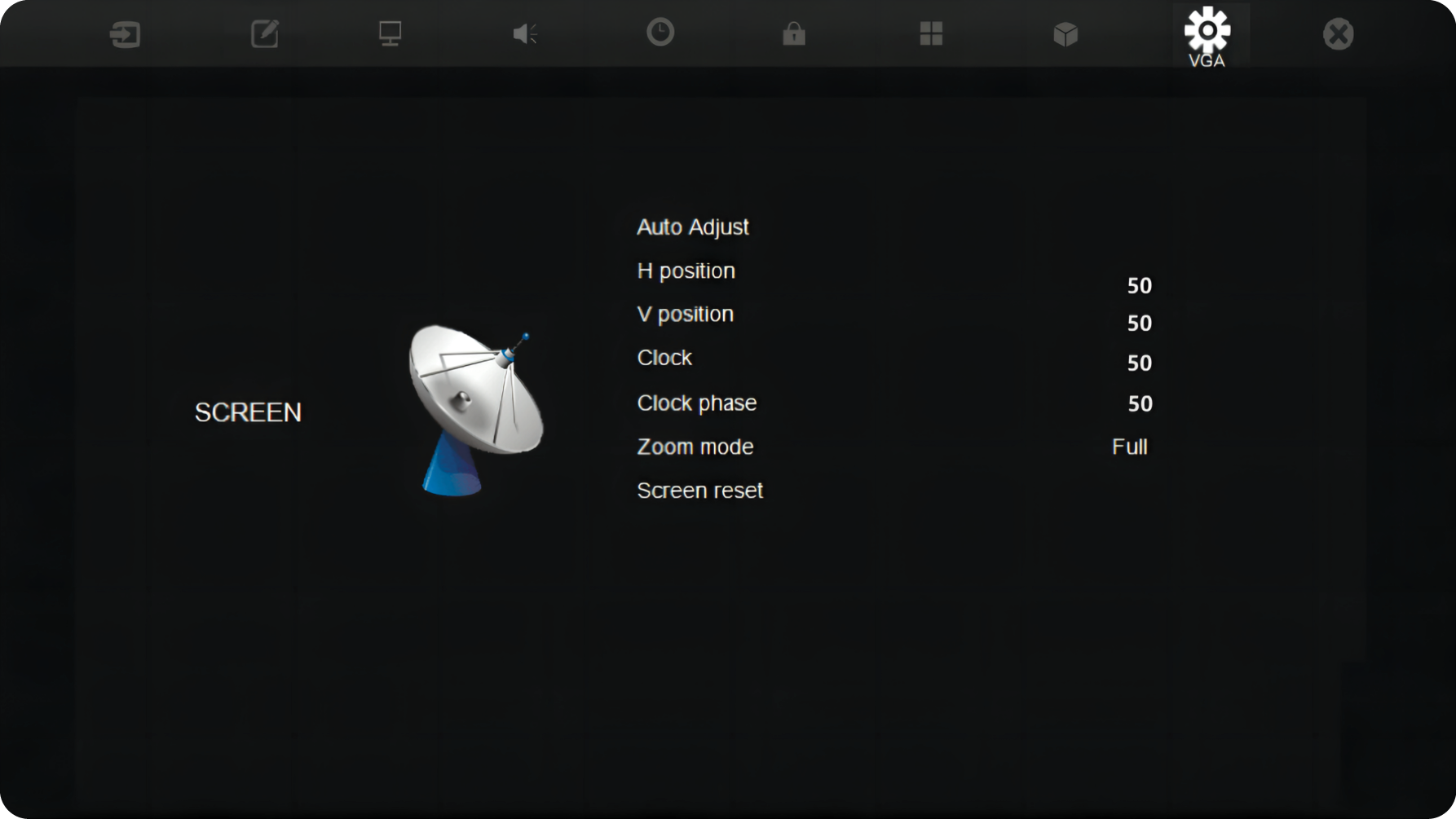
Open the OSD Menu by pressing MENU on the remote control or the ![]() Menu button on the front Control Panel.
Menu button on the front Control Panel.
VGA
| Item | Description |
|---|---|
| H Position | Adjust the screen image position horizontally. |
| V Position | Adjust the screen image position vertically. |
| Clock | Adjust the frequency of the pixel clock signal. This will affect the resolution and refresh rate. |
| Clock Phase | Adjust the clock phase to improve the display’s clarity and avoid flickering. |
| Zoom Mode | Select the aspect ratio of the display. |
| Auto Adjust | Automatically adjust the position of the screen image. |
| Screen Reset | Reset the Screen settings to their default settings. |
Input Source
WriteAway
| Item | Description |
|---|---|
| Off | Turn off the WriteAway function. |
| Except PC (OPS) | Can be used for all channels, except OPS. |
| No Signal Input Only | Can be used when there is no signal input. |
| Black Board Mode
(Auto Signal Detection: Off) |
Can be used when there is no signal input; auto-detection will be disabled. |
Picture
| Item | Description | ||||||||||
|---|---|---|---|---|---|---|---|---|---|---|---|
| Picture Mode | Select a predefined picture setting.
| ||||||||||
| Contrast | Adjusts the difference between the image background (black level) and the foreground (white level). Use this to set the peak white level after you have previously adjusted the Brightness setting to suit your selected input and viewing environment. | ||||||||||
| Brightness | Adjusts background black levels of the screen image. The higher the value, the brighter the image. Lower values will result in a darker image. | ||||||||||
| Color | Adjust an image from black and white to fully saturated color. | ||||||||||
| Tint | The higher the value, the more greenish the picture becomes. The lower the value, the more reddish the picture becomes. | ||||||||||
| Sharpness | A high value results in a sharper picture; a low value softens the picture. | ||||||||||
| Color Temperature | Adjust the color temperature value.
| ||||||||||
| Noise Reduction | Reduce image noise and distortion. | ||||||||||
| Overscan | Automatically enlarge the original picture horizontally and vertically to an equal aspect ratio that fills the screen. | ||||||||||
| RGB Range | Manually change the color format options to fit the correct color format range if the colors are not displayed correctly. | ||||||||||
| Flicker Free | Reduce or eliminate screen flicker. | ||||||||||
| Blue Light Filter | Adjust the filter that blocks high-energy blue light for a more comfortable viewing experience. | ||||||||||
| Gamma Set | Reflect the relationship between input source and picture brightness. | ||||||||||
| Backlight | Adjust the backlight value. | ||||||||||
| Picture Reset | Reset the Picture settings to their default settings. |
Audio
| Item | Description | ||||||||
|---|---|---|---|---|---|---|---|---|---|
| Volume Control | Select which component has sound and controls the volume.
| ||||||||
| Treble | Increase or decrease the treble level (higher-pitched sounds). | ||||||||
| Bass | Increase or decrease the bass level (lower-pitched sounds). | ||||||||
| Balance | Adjust the left/right speaker balance. | ||||||||
| Volume | Increase or decrease the display’s volume level. | ||||||||
| Maximum Volume | Set the display’s maximum volume level. | ||||||||
| Minimum Volume | Set the display’s minimum volume level. | ||||||||
| Mute | Toggle mute on or off. | ||||||||
| Audio Out Sync | Sync the Audio Out Volume (Line Out) with the display’s speakers. | ||||||||
| Audio Out Volume
(Line Out) |
Increase or decrease the Audio Out volume level. | ||||||||
| Audio Reset | Reset the Audio settings to their default settings. |
Time
| Item | Description |
|---|---|
| Off Time | Set a time for the ViewBoard to automatically power off. |
| Date and Time | Set the ViewBoard’s system time and format. |
| Schedule | Set up to seven different time intervals for the display to be active. |
| OSD Turn Off | Set the length of time the OSD Menu remains on screen. |
| Input Information | Set the length of time the input information will be displayed on the display. |
| Automatic Date & Time | Automatically set the date and time. |
| Time Reset | Reset the Time settings to their default settings. |
About
| Item | Description |
|---|---|
| Display Information | See information about the display: Model Name, Serial No., Operation Hours, and Software Version. |
Advanced Options
| Item | Description | ||||||||||
|---|---|---|---|---|---|---|---|---|---|---|---|
| Saving | Panel Saving
When enabled, the ViewBoard display’s brightness will be limited to 40% of its maximum brightness level. Power Save Select one of the power saving modes to enable power saving.
Power LED Light Turn on/off the ViewBoard’s power indicator light. | ||||||||||
| Boot | Boot On Source
Select which input source to use when the Viewboard is powered on. Boot On Logo Select a boot up logo to display when the ViewBoard is starting. | ||||||||||
| Signal | Auto Signal Detection
Enable to automatically detect input sources and display them. No Signal Standby Enable to go to standby mode when there is no input source detected. | ||||||||||
| Port | HDMI with One Wire
When ON, HDMI CEC will be enabled. HDMI CEC synchronizes device power on/off operation via HDMI connection. USB Cloning Import/export OSD Settings to a USB storage device. USB Auto Play When on, the ViewBoard will copy media files from an external storage device (e.g., USB drive) to internal storage, then play the media files automatically. | ||||||||||
| Others | Switch On State
Select the display status for the next time the power cord is connected to a power outlet.
WOL (Wake On LAN) When on, the ViewBoard will turn ON automatically after plugging in a LAN cable when the screen is off. Monitor ID Assign a number to remote control the display by RS-232. NOTE: The number range is: 1~98; 99 is reserved for “All Displays”. OSD Language Set the preferred language for the ViewBoard. Factory Reset Reset all OSD Menu settings to their default settings. Advanced Options Reset Reset the Advanced Options settings to their default settings. |
Other Settings
| Item | Description |
|---|---|
| Energy Star | Toggle Energy Star on or off. |
| Light Sensor | Toggle the light sensor on or off. |
| IP | View the current IP address. |
| Port | View the current port number. |
Leave OSD Menu
Low Blue Light Filter and Eye Health
The Blue Light Filter blocks high-energy blue light for a more comfortable viewing experience.
Calculating Breaks
When viewing screens for extended periods, it is recommended to take periodic breaks from viewing. Short breaks of at least 10 minutes are recommended after one (1) hour of continuous viewing.
Taking shorter, more frequent breaks are generally more beneficial than longer, less frequent breaks.
Focus Fatigue (20-20-20 Rule)
To reduce the risk of eye fatigue by constantly looking at the screen, look away from the screen at least every 20 minutes and gaze at a distant object (at least 20 feet away) for at least 20 seconds.
Looking at Distant Objects
While taking breaks, users can further reduce eye strain and dryness by focusing on objects that are further away from them for 10-15 seconds, then gaze at something up close for 10-15 seconds. Repeat this up to 10 times. This exercise reduces the risk of your eyes’ focusing ability to “lock up” after prolonged computer work.
Eye and Neck Exercises
Eye Exercises
Eye exercises can help minimize eye strain. Slowly roll your eyes to the left, right, up, and down. Repeat as many times as needed.
Neck Exercises
Neck exercises can also help minimize eye strain. Relax your arms and let them hang at your sides, bend forward slightly to stretch the neck, turn your head to the right and to the left. Repeat as many times as needed.

